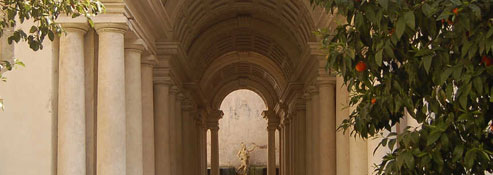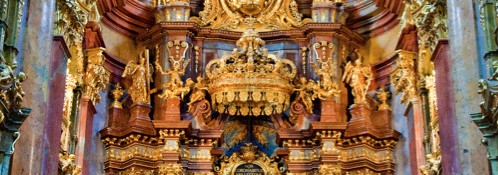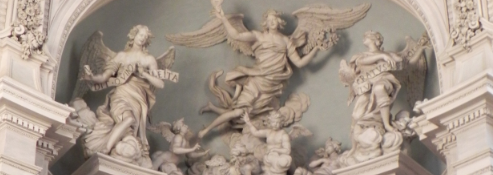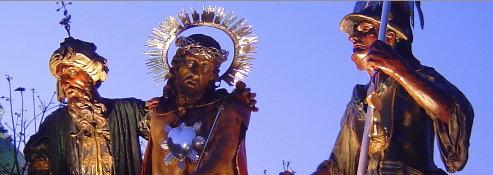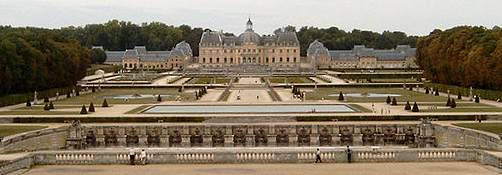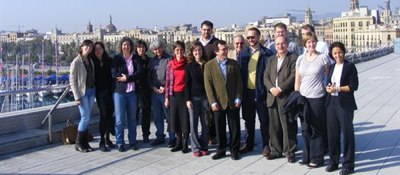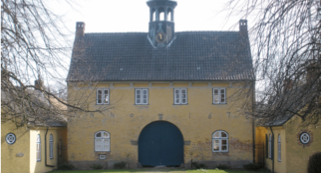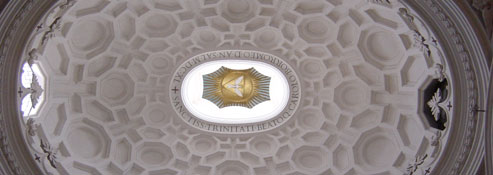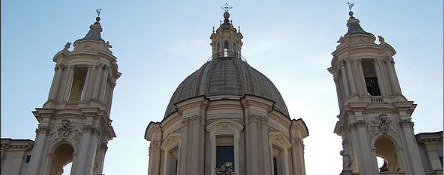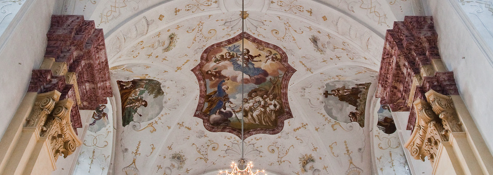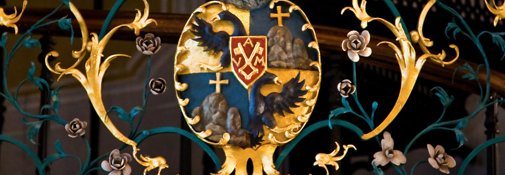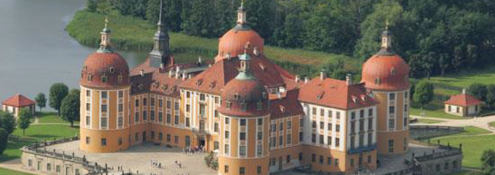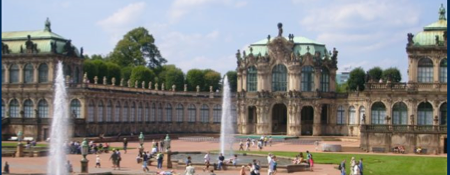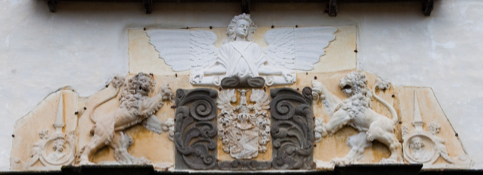The monograph Ars moriendi in Polish literature of the 15th and 16th centuries [1] illustrates that texts devoted to the art of a good death bore the hallmarks of medieval anthropology, popularized European models in Polish culture, and did not possess unique features. Original elements appeared only in the art and literature of the Sarmatian Baroque. The intensity with which Sarmatism adopted eschatological themes, demonstrates the success of post-Tridentine moralizing and the interiorization of a new model of culture. With this in mind, I wish to present the collective experience of the eternal things that combine the misterium tremendum with life hic et nunc, as well as the system of values formed in the Sarmatian culture, which over time dissipated and manifested tendencies to crisis.
The First Aspect: the mystery of death in the spectacle of the pompa funebris
A permanent testament o
The monograph Ars moriendi in Polish literature of the 15th and 16th centuries [1] illustrates that texts devoted to the art of a good death bore the hallmarks of medieval anthropology, popularized European models in Polish culture, and did not possess unique features. Original elements appeared only in the art and literature of the Sarmatian Baroque. The intensity with which Sarmatism adopted eschatological themes, demonstrates the success of post-Tridentine moralizing and the interiorization of a new model of culture. With this in mind, I wish to present the collective experience of the eternal things that combine the misterium tremendum with life hic et nunc, as well as the system of values formed in the Sarmatian culture, which over time dissipated and manifested tendencies to crisis.
The First Aspect: the mystery of death in the spectacle of the pompa funebris
A permanent testament of the experience of death was recorded in Sarmatian Baroque funerary celebrations, which were accompanied by sermons and speeches, sentential texts, commemorative and panegyric prints, and poetic cycles composed by relatives, friends or commissioned writers. The program of the pompa funebris, which was presented in a fascinating way by Juliusz Chrościcki, [2] featured the transporting of various parts of the body, such as the heart and arm, to places associated with the deceased. Those acts were accompanied by feasts, hunting and firework displays. The culmination was a funeral, which lasted for a number of days. The same funeral was announced by the tolling of bells, and preceded by church celebrations where the interior was adorned with black and purple drapes, and illuminated by the glow of countless candles. The church was also filled with the smoke of incense, and decorated with the trophies and emblems of the deceased, incorporated into the iconographic program of the festivities. The coffin rested on a catafalque - a castrum doloris, made by eminent artists and masters of circumstance architecture, and to which Turkish or Tatar prisoners were chained. A pageant enacted the entry into the temple of mounted knights, which included an Archimimus falling from a horse in the dead man's armor, and the breaking of his weapons. There was then a solemn procession of representatives of all states, which culminated in the lowering of the body into the grave into which were thrown the coat of arms and the weapons of the deceased. This was followed by a banquet. Not only the participants in the funeral were present at this feast but also the gathered crowds of plebs and beggars.
In the pompa funebris a dominant role was played by sermons and eulogies. This hypertrophy can be seen in an account of the funeral of Józef Sanguszko:
Po sprowadzeniu […] ciała do Lubartowa […] z kazaniem wybornym przez Imci ks. kapucyna w kościele parafialnym lubartowskim […]. Summę zaś i kondukt biskupim obrządkiem śpiewał J.W. Imć Ksiądz Lenczowski […], a kazanie wyborne miał I. Ks. Superior Domu lubelskiego Congregationis Missionis z wielkim zbudowaniem licznie znajdujących się gości […]. Nazajutrz […] zaczęta eksportacyja ciała śp. J.O. Księcia Imci Marszałka przy kazaniach wybornych pierwszym w kościele […] drugim w drodze […] mianych do Lublina […] na cmentarzu kapucyńskim było kazanie wyborne […]. A po ustawieniu tegoż ciała na katafalku wspaniałym […] tę eksportacyję zakończyło kazanie wyborne przez I. ks. kapucyna miane […].
Summę […] śpiewał J.W.I. Ks. biskup Abderytański, sufragan lubelski, a kazanie wyborne miał W.I. Ks. Odyński […]. Po skończonej summie i kazaniu J.O. Książę Imć Wojewoda Poznański miał mowę w stylu arcywybornym i wszystkich zaszczycających ten akt dystyngwowanych gości […] na obiad pogrzebowy zaprosił […]. W konwencie zaś W.W. kapucynów stoły otwarte były dla wszystkiego duchowieństwa […] aż wreszcie po summie i kazaniu […] nastąpił kondukt wielki przez J.W.W. biskupów przy odgłosie setnym z armat danym i ciało […] złożone w grobie książęcym. [3]
[After bringing […] the body to Lubartów […] an exquisite sermon was delivered by a Capuchin in the church of Lubartów […]. Fr Lenczowski delivered the episcopal rites and led the procession [ …] and an exquisite sermon was delivered by a Superior of the House Congregationis Missionis of Lublin […]. The next day, […] exportation of the body began with the first sermon in the church […] the second on the way […] by procession to Lublin […]. In the cemetery an exquisite sermon was delivered […]. And after setting the body of the Marshall & Duke upon the wonderful catafalque […] this fine exportation was completed by yet another exquisite sermon […].
[The summa […] was sung by the Bishop Abderytański, the suffragan of Lublin, and an exquisite sermon was delivered by Fr. Odyński […]. On completing the summa and sermon the Duke and voivod of Poznań gave an absolutely exquisite speech for the distinguished guests […] invited to the funerary dinner […]. In the Capuchin abbey tables were open to all clergy […] and after the summa and sermon […] the bishops led a procession to the sound of cannon fire […] the body was placed in the ducal tomb.]
Over the course of the two-day celebrations, nine "exquisite" sermons and one "absolutely exquisite" speech were delivered. The rhetorical splendor of the sermon, together with the majesty of the funerary catafalque, proved to be an experience which inspired a sense of fear and awe.
The theater of death fascinated both the laity and the religious, as evidenced by the statements of Fr. Jakub Gawatowic or Fr. Józef Pietkiewicz. [4] Even Piotr Skarga, the moralist, suspended his discourse in order to admire the "tower of funerary tears" made by Giovanni Battista Ghisleni, accompanied by "the finery […]", "the lamentations of the superior, flames, waxes, bells, the gathering of the good and the great, the costs of covering the body […] and the singing and playing of funerary hymns." [5]
Although funerary sermons were distributed in the occasional prints of sermons, or as part of a compendium of sermons of the given author, their primary form was oral, and - as indicated by the words triste spectaculum, haec scaena, theatrum funebre [6] - were embodied in the funerary spectacle. The priest's contribution took on a theatrical quality, reporting the course of the play and consolidating the atmosphere of the Sarmatian mysteries of death. At the same time, the priest's sermon co-created the religious and social significance of the ceremony, the effect of which was the unity of word and image; the synthesis of auditory experience (the sound of bells and music) and olfactory sensations (the smell of incense and candles); the union of symbolic signs (especially emblems) and visual concreteness: the events of the life of the deceased, a coffin portrait and a view of the body, devoured by the "spider years" (as explained by Fr. Michał Kuncewicz at the funeral of Stanisław de Wypych Wypyski), and now subject to decay. Jan Cynerski-Rachtamowicz enumerated in his Columna oborsciana variations on the theme of the heraldic column, disrupted by the death and prompted those present to contemplate the mournful spectacle.
Sed tamen postquam fatali necessitate columna haec subruta est, nobis nihil praeter triste spectaculum et minuta rudera mortalitatis reliquit. Et tametsi ille plenus dierum mertirorumque; in haec scaena fabula vitae aptè prudenturque peregit, tamen nobis operae precium est videre ac serio contemplari. [7]
The phrase videre ac serio contemplari recognizes the essence of these texts, aspiring as they did to illuminate and penetrate cognitive and communication codes. The literariness of Renaissance moralizing, going hand in hand with the rationality of docere and persuadere, made way for intensive permovere, which appealed more to the senses and emotions than to reason. It gave way, by affective stimulations, to the awakening of contemplation, and finally manifested the mystery of the transition to eternity. Like a Baroque opera, the funerary spectacle should be interpreted as an integral metaphor by which all languages of theatre express the mystery of death.
Elements of mystery present in the funerary rites (that are also common to opera) justify this amplification. One "exquisite sermon" would not bring those who listened in excelsis, it would only, like a Renaissance laudation, serve to console those in attendance. However, if the concelebrants gave nine orations, there arose a "column" or a "tower" by which it was possible to climb almost to the sky…
One does not need to recall that the Baroque depended on hyperbole and congeries that edified ad maiorem Dei gloriam structures, which astounded with their immensity. Such intentions we observe in the following laudations.
Z największych okrutników czyniono miłosiernych filantropów, a z rozpustników, zdrajców i pijaków - przykładnych ojców rodzin i obywateli. […] Już współcześni nazywali tego typu panegirystów bałwochwalcami […]. W Polsce dymem kadzideł upajali się wszyscy, którzy mogli cokolwiek za nie ofiarować.
[The cruelest were made merciful philanthropists, whereas fornicators, traitors and drunkards - exemplary fathers and citizens. […] Contemporaries called these types of panegyrists as idolaters […]. In Poland, the smoke of the incense was inhaled by anyone who could make an offering.]
So wrote Janusz Tazbir, [8] recalling that eulogies accounted for about 30 percent of published works in the 17th century. It is understandable, therefore, that the findings of the Synods in Gniezno (1643) and Poznań (1642, 1738) attempted to rein in the grandiose eloquence of concelebrants, [9] and the testaments written in articulo mortis discourage the entering into of financially ruinous funerals. [10] These efforts proved futile, however, since ostentatious funerals were seen as confirming the prestige and wealth of a family. And yet, there was method in this madness, as the said display of ostentation retained great power of persuasion.
It is worth noting that the defenders of panegyric amplification, who were branded by opponents as "idolaters", made recourse to Renaissance poetics, which proposed that of the dead one speaks aut nihil, aut bene. However, if the character of the deceased was to be a role model, idealization and hyperbole were legitimate. Moreover, if rhetoric intensity was admitted by reason of aesthetic preference and custom (listeners, bombarded from all sides by the shouts of the booming orators, could only absorb a limited number of messages), then we may equally understand the introduction of exaggerated imagistic, emotional, and auditory aspects.
Located in the mystery, a funerary laudation elevated the life of the deceased not only to the level of role model, but also to the heights of the Sarmatian sacrum: religious, agrarian, family, and military. It was not so much a question of instructing and encouraging people to follow the path of the deceased person's life, but of bringing the individual and the collective (participants in the rite) to the realm of the metaphysical. Therefore, the Renaissance ethic transparency of laus vitae was replaced with the transparency of ideas, consolidating Sarmatian society, and represented by the dead.
The religious idea, present in the mysteries of mourning, came to the fore in the virtues of Sarmatian men and women, who aimed, by worthy living in the Catholic faith, to make a journey to the heavenly Republic. We may note how women such as Agnieszka Kamieńska, Agnieszka Gołuchowska of Sandomierz, and the saintly Alojza Ostrogska, most commonly exemplified the religious idea. [11] Their image was constructed along the models of male nobility, but they also displayed a more visible zeal in their reception of the sacraments, their devotion to motherhood, their hard working lives - full of suffering and self-sacrifice, and their watchfulness over both their family and local community. They also displayed a Christian preparedness for death.
The idea of oneness with the soil was embodied in the figures of Nestors, who returned to the earth after a long and fruitful life, "as mature ears of corn". An example is the Gniazdo szlacheckie [Noble Nest] of Wojciech Czarnocki. [12] The hero of this sermon dies in peace and dignity, having overseen the successful running of his household, reconciling with his loved ones, and having given his blessings to his children.
The knightly ideal was reflected in the heroic deeds of the fallen on the battlefield. The belief that blood sacrifice brought the fallen into the company of saints had allowed the sermon of the Angel of Saint Teresa to identify a recent "heretic", Stefan Grudziński, with David - an Old Testament type of Messiah.
Dziś widzę na katafalku niedobyty zamek, ale pusty, bez strażnika, abo lepiej rzekę, jest, lecz obalony. Jego M[iłość] Pan Stefan z Grudny na Ryczywole Grudziński już nie in porta vitae lecz mortis, nie w bramie żywota, ale śmierci. Już nie w zbrojnym kirysie, lecz w śmiertelnym gźle, już nie stojący w kroku, ale poległy na pobojowisku-katafalku, już nie z mieczem w ręku, ale u śmierci w łyku. […] A choćby też wszyscy milczeli, mówiłyby te chorągwie, które u trunny leżą. […] Mowiełyby jeszcze szwanki i rany podjęte, iże on był fortis armatus custodiens atrium suum. [13]
[Today I see on the catafalque an unconquerable castle, but empty, without guards, or I say, it is, but toppled. Lord Stefan of Grudna on Ryczywol Grudziński is no longer in porta vitae but is now in porta mortis. Now no longer in his armour but in his shroud, no longer standing tall, but dead in his catafalque […], no longer with a sword in his hand, but in death's captivity […] And if all were silent, the banners would reveal who lies here. […] His wounds and trials would testify that he had been fortis armatus custodiens atrium suum.]
Let us note that the metaphysical context of the 17th century eulogy brings it closer to the epicedium of antiquity than the funeralia of the Renaissance, [14] which were addressed to the living (for example, the epicedium of Jan Kochanowski O śmierci Jana Tarnowskiego… [On the death of Jan Tarnowski…] is addressed to his son Jan Krzysztof). The Baroque eulogies create misterium, which allowed the Roman soul to soar to heaven (ad sidera) during the cremation of the body and for the Sarmatian to enter the heavenly Republic and take his seat in the pantheon of his ancestors. The examined texts showed to those present at the ceremony a Sarmatian earth-like heaven ruled by the Queen of Poland. The patron saints and ancestors give witness to the history of national glory. This picture emerges, for example, in the sermon of Samuel Brzezewski: Prawo z śmiercią, aniołami i niebem…[The law of death, angels and heaven...]. [15]
The symbolic essence, which permeated the entire emblematic-conceptual rite, took on a particular expressiveness in the eschatological perspective. The funerary orator was the interpreter who explained the symbolic sense of circumstantial architecture and its accompaniments. The expressive intensity of military funerals proved that chivalry lay at the heart of the Sarmatian sacred space.
The Second Aspect: death in media vita
The most original part of the pompa funebris was the coffin portrait of the deceased, which was located at the front of the coffin resting upon the catafalque. [16] The portraits remind us that the aspirations of the funerary eulogy to create a mystery coexisted with the realism of the spectacles. The radical clash of the two orientations - "Upwards", ad caelestem patriam, and "Downwards", in media vita, would have been alien to Renaissance poetics, which required that an expression of praise included a particular biography with the ideal social model. In Baroque sermons this collision is frequent. In the cited sermon of the Angel of St. Teresa, the curtain of the edifying spectacle was indiscreetly opened.
Nie trzeba Stefanowi Grudzińskiemu od malarzów chorągwi do grobu zaciągać, nie trzeba mu ich w kramie kupować, oto są te, które mężnie przywodził, oto są te, pod którymi zdrowie łożył.
[You do not need painters to make banners for Stefan Grudziński, you do not have to buy them from a stall. Here are those banners which he courageously carried and under which he died.]
Fr. Modest Pierzakowicz unveiled the "bitterness of death", "the delicacies and caresses of this world":
Tym kiedy przyjdzie umierać, och, jako rzecz przykra […]. Boże uchowaj doktorowi serio mówić o śmierci, napominać pana, aby dom swój rozrządził […]. Więc kiedy doktorowie odstąpią, a kapłan perswaduje, aby przynajmniej olej św. mógł włożyć już na śmiertelnego, jaki krzyk około tego bywa, wiecie sami. [17]
[Thus when it comes to dying, oh, what a sorry thing […]. God forbid the doctor from talking about death seriously and exhorting the noble to make order in your house […]. So when doctors depart, and the priest insists that he anoints the body, there are such screams and shouts, as only you know.]
Hilarion Fałęcki drew portraits of the moribund in the moment of recognition of the falsehood of family affects.
Pojzrzy na ścianę:
Rządziki oprawne, szabelki i inne apparencyje
Pozbierano, sepety wypróżniono.
Dobrodzijka
Jedną go za szyję trzyma ręką,
Skazuje drugą,
Żeby mu prędko szyli zgrzebnicę śmiertelną. [18]
[He looks at the wall,
The Saddle, and collected
Accoutrements, cupboards emptied.
His wife with one hand around his neck
Orders for a shroud
To be promptly made],
In addition to the details captured by moralists and misanthropists, the realities of life made an appearance in panegyric funerary in the belief that, not only virtues and heroic deeds, but the entire Sarmatian temporality would enter the realm of eternity. This is evidenced in the descriptions of the heavenly feasts celebrated within an earthly setting. From this perspective, the coincidentia oppositorum, which gave funerary texts an ideological and aesthetic duality, reveals unitas. Both contemplation of the mystery of death and exemplary customs, anecdotes, remembered details, are implanted in the trunk of eternity, becoming in the eyes of God worthy of life in the heavenly homeland.
Let us note that in these texts the poetics of the concrete have a theological correctness, which is in keeping with the magisterium of the post-Tridentine Church. Salvation - so the funeral concelebrants seemed to say - includes not only the spirit cleansed of earthly vices, but everything of the world that man loves and respects in the collective and the individual existence. Pursuant to Redemption, the profanum sphere is permeated with sacred light, and the distance between heaven and earth is reduced to a single crossing of the threshold of porta aeternitatis.
Such a belief facilitated the translation of lay (Renaissance) models of funerary praise into the realm of the religious vision of life. Observation of this transfer may serve in discussions of Sarmatian Baroque religiosity, explaining its ambivalences: mystical longing and the interpretation of the biological life in religious terms, and vice versa - an overwhelming need to "take all things in a bodily sense" and give shape to religious visions in earthly terms. [19]
The Third Aspect: enhancing and the crisis of the system of values
Axiological statements about death derived from mediaeval tradition. In the semantic field of the world to which moribundus bade farewell to, counter-values (mundus immundus, fraus mundi) and negligible values (subject to the passing of time and futility) were all recorded. [20] Presented on this background, the personification of death took on the attributes of a triumphant ruler - as in Petrarch - and was merged with the personification of Time-Saturn (mors edax). Often death also took on epithets of ancient provenance (ruthless, but also - as in Horace - just: who, with an even hand, haunts both huts and palaces).
Considered in the light of the principles de novissimis, death became a counter-value as a result of original sin, the cause of anxiety and suffering of all humanity, and the despair of sinners. Meditation on death in the context of sin evoked convulsive images of agony and the dissolution of the body, appealing as much to the Baroque imagination as it did to the folk (and often, crypto-pagan) imagination.
In addition to the frenetic is also depressive melancholy. Many spiritual melancholies popular in the era of the late Seicento expressed apathy and resignation from the struggle to save one's soul. In view of these sentiments, therapies for fear of death or acedia were featured. Moreover, in the writings about eternal things there appeared elements such as medicina animae, derived from Seneca and Cicero, enriched by the masters of early Christianity and the medieval era, as well as Erasmus, Ignatius Loyola and the post-Tridentine teachers of the spiritual life.
In the light of the redemptive sacrifice of Christ, death is seen as a passage to eternal life. The notion of the redemptive life was a common, non-denominational Christian part of the creed, but was especially prominent in the Protestant funerary ritual recalling the early Christian liturgy. In the sphere of Catholic literature and poetry were to be found expressions pertaining to the reversibility of the concepts of "life and death" and a reassessment of temporal illusions, hiding the fact that true life begins after death, whereas the temporal existence of sin is the choice of eternal death. These reflections stimulated a conceptual game by way of oxymoron, characteristic of a poetry aspiring to the mystical experience, particularly the Carmelite experience, as well as for a poetry derived from the petrarchismo spirituale.
More common in the observed cultural circle was the active and voluntary interpretation of death associated with the tradition of the Renaissance. Suggestive images of the victorious "duel of the brave Sarmatian with wanton death" [21] sustained the vitality of humanistic and Christian anthropology, which was based on the belief that the irrevocability of death cannot destroy human freedom. This brought to the fore the learning de dignitate homini in the new historical circumstances, and formed a part of the Sarmatian axiological system.
Death on the battlefield, with a saber in one's hand, testifying to the sovereign choice of values taken in liberty. The life remained a primary value, but was subordinated to the highest value: that of sacrifice for the nation and the Catholic faith. The value of knightly fame was regarded with ambivalence in certain quarters. In a number of texts (such as those of Sęp Szarzyński) there appeared doubts as to whether the sacrifice of one's life for glory and honor was a part of the Christian ethos. In other texts, such as in the poem of Vespasian Kochowski, Nagrobek mężnym żołnierzom na batowskich polach zginionym [The Grave of Valiant Soldiers on the Batowskie Fields], the role of fame was elevated:
Nie straszna śmierć, jónaku, nie boi się rany,
Droższa sława, Polaku, niż żywot kochany… [22]
[Death is not so terrible, o young soldier, do not fear wounds,
Glory is sweeter, young Pole, than beloved life…]
Confronting death on the battlefield taught men how to overcome fear and gave them an opportunity to defeat their adversarial death through martial endeavor, described in terms of a sporting diversion. When, however, in a duel "with wanton death" the Sarmatian knight died, his death had an existential meaning. It refreshed the shine of the ancestral seal and confirmed identity by way of both the individual and the collective, so that the fallen "may present to the Court of the Great Judge who he was in life and give an account of his deeds". [23]
It should be noted, however, that in the literature of the Polish Baroque there also appeared ideologically and aesthetically different images of the death of enemies, especially the Turks, of miscarried fetuses and characters from the margins of society: a drunkard, an old prostitute. They presented death at the level of the animal, [24] foregrounding the ugliness of a decaying corpse as a sign of the misery and degradation of man. Their naturalist message and libertine contestation of Christian metaphysics was often in evidence. In this area (especially in the poetry of Jan Andrzej Morsztyn), images of death were also depicted as being the peak of sexual experience.
The presented opposition is clear. More complicated and resistant to interpretation is the meditation on death elevated on the basis of the meditative poetry of the late Baroque, which created an image of eternal things different from that which promoted socially accepted values. It combined the theme of death with considerations about the passing of life, which is like a bubble, a fleeting blossom, a blade of grass, a spark extinguishing in the "blink of an eye". In such meditations, the time given to man appeared as a "momentary nothingness" between birth and death:
O ciężka godzino! O momencie niezbyty!
Punkciku w żałości, w strachy, sromotę obfity! [25]
[O hard hour! O unrelenting moment!
Given to loss, fear and great shame!]
The trauma associated with the passing of time intensified in tandem with poetic reveries, wherein compulsive thoughts of eternity filled with the prospect of hellish ordeals:
O wieczności nieskończona,
W głębi swojej niezbrodzona,
Trapisz serca, suszysz kości,
Rozum tępisz, o wieczności!
Liczę wieków miliony,
A jeszcze kres niezmierzony;
Kędy kończę, to począłem,
Kędy idę, to stanąłem.
[O never ending eternity,
In the depths of your purity,
You clutch the heart, you dry bones
You condemn reason, o eternity!
I count the endless centuries
Beyond the point of seeing
Where I end, I begin
When I journey, I stand still.]
Obsessions about the vanity of the world were accompanied by a sense of pending disaster. Death - the only ruler of the universe - not only destroys humans and living beings, but the entire cosmos:
Śmierć następuje, mijają lata
[………………………]
Wszystko ustaje, nic nie zostaje,
Wszystko przecz ginie, jako śnieg taje. [26]
[Death follows, the years pass
[…………….]
Everything proceeds, nothing remains.
Everything is fleeting, like snow in the fields.]
In a world tyrannized by death there is no longer a regular, friendly astronomical time (aevum) or an individual time, continuing until maturity (tempus), but a terrifying rush towards death. Where Renaissance neo-Stoics saw comforting aeternitas entered in the perpetual wheel, Baroque poets recognized paroxysms of agony - of day and night, seasons and centuries:
Na łeb lecą dni, na karki,
Gdy je zacinają Parki.
[Days pass at a hasty pace
When the Parcae cut them short.] [27]
Meditations about vanitas and cosmic paroxysms eclipsed the fundamental truths of Christianity with pessimism, [28] passivity, fear and escapism, and narcissistic melancholy.
Cóż jest żywot? Strach śmierci.
Cóż śmierć? Koniec strachu. [29]
[What is life? Fear of death.
What is death? The end of fear.]
The world, seen as the dominion of death, lost brightness, clarity, order, harmony and proportion. It is no accident that a collection of poetry by Piotr Franciszek Alojzy Łoski carried the title Lutnia rozstrojona [The Untuned Lute] (1734). The breakdown of a coherent optimistic doctrine of Renaissance classicism opened the door to experimentation in the area of "beauty trampled", as defined by Mario Praz [30]: the unbridled imagination absorbing all sensory stimuli, a penchant for the macabre. In the cited works we see - in heaven and in hell - unceasing banquet tables laid out in accordance with Sarmatian taste. Grave crypts amaze with their worn satin drapes, bloodstained velvet, and broken columns. The procession qui ante nos fuere gives clarity to surreal colours and shapes. [31]
Both aesthetics of the representations of death, foregrounding the macabre, the frenetic, sometimes the grotesque, and their ideological message seem to confirm the Nietschean Apollonian and Dionysiac antonym: two elements from which there emerges either the beauty of light: reason and restraint, which is present in images hiding the difficult truths about life, or the beauty untamed: ecstatic and wild, which allows you to experience reality as it is in its essence. The vision outlined in The Birth of Tragedy gave rise to the historiosophical argument concerned the alternation of Apollonian "epochs", governed by rationality; and "Dionysian", revealing deep experience and primordial emotions. In this perspective, the era of the Apollonian would be the Humanist Renaissance foregrounding the anthropology of dignity and the freedom of man endowed with reason, free will, and classicist aesthetics. The Dionysian epoch was Baroque, which recognized wasteful endeavour, the passing of time, and the tragedy of existence.
An indicator of this opposition was the theme of transience and death. [32] In the era of the Renaissance - as argued by Alberto Tenenti in a superbly documented monograph Il senso della morte e l'amore della vita nel Rinascimento, [33] the passage of time was experienced as a natural aspect of life from birth, through childhood and adulthood to old age, which enjoins people to take pleasure in making Man completely fulfilled. This entails Man realizing all personal potential through creativity and conveying to his descendants biological life, acquired wisdom and the fruits of personal effort. [34] In this regard, the end of life - quiet and gentle like a dream - does not arouse fear. [35] For that which is the essence and value of life is not annihilation, but will remain in the memory of future generations and the written word, which is more durable than bronze. The optimistic anthropological myth of the Renaissance saw its end (as evidenced by supporters of the interpretation of the Baroque era as an antithesis of the preceding era) together with the decomposition of the Renaissance humanitas. An illustration of this is the drama of Pedro Calderon de la Barca la Vida es sueño [Life is a Dream] (1635), whose very title disturbs the harmony established in this myth.
Of course, the antithetical concept is simplified and schematic. Literary and artistic works of the 16th and 17th centuries demonstrate a considerable variation, so in the ideas penetrating the Renaissance humanist culture, often pessimistic, as in the ideas expressed in the culture of the Polish Seicento, which, as we have shown, is not limited to dolor, but testifies to the vital forces of society, proclaims the heroic chivalrous death, brings order to the conditions of the landed gentry, the dignity of family life, disrupted by the "regrettable divorce of a spouse", but regenerating shortly after the loss of a loved one. There is no doubt, however, that spiritual melancholy, born under the sign of Saturn, is a testament to the deep ideological crisis experienced in a state of acedia. The authors affected by such melancholy did not know how to impart the possibility of transformation and development, which a crisis situation entails. This can be ascribed to the state of mind caused by external conditions such as the trauma of the Swedish invasion, and the political and economic decadence of the Republic. However, I believe that an important reason was spiritual: the end of hope for life and a New Beginning; the loss of hope, not only temporal but also eschatological, the eclipse of the Gospel of the Good News. A similar ideological phenomenon was marked by the aesthetic sensitivity - if we believe Johan Huizinga - in "the autumn of the Middle Ages". Up until then Polish culture had flourished without having been subjected to any serious crisis. This crisis was only felt in the era of the Seicento, where 'a flourishing gave way to the withering' of Sarmatian culture.
*Translated by Barry Keane
Notes
1. See MACIEJ WŁODARSKI, Ars moriendi w literaturze polskiej XV i XVI wieku [Ars Moriendi in 15th and 16th-century Poland], Społeczny Instytut Wydawniczy Znak, Kraków 1987; ALINA NOWICKA-JEŻOWA, Pieśni czasu śmierci. Studium z historii duchowości XVI-XVIII wieku, [Songs at the Time of Death] Wydawnictwo Towarzystwa Naukowego KUL, Lublin 1992; EADEM, Sarmaci i śmierć [Sarmatians and Death], Wydawnictwo Naukowe PWN, Warszawa 1992,
2. JULIUSZ CHROŚCICKI, Pompa funebris. Z dziejów kultury staropolskiej [Pompa funebris. From the History of Old Polish Culture], Państwowe Wydawnictwo Naukowe, Warszawa 1974.
3. Mowa […] Wojewody Poznańskiego […] Antoniego Jabłonowskiego […] na pogrzebie J.O. Księcia Imci Józefa Sanguszka, Marszałka Wielkiego Ks. Litewskiego miana z Lublina die 4 Augustii 1781. [Speech - Voivode of Poznań […] Antoni Jabłonowski […] at the funeral of Duke Józef Sanguszko, Marshall of Lithuania, August 1781], fo. 2r.-v.. The print features a description of the ceremony.
4. JAKUB GAWATOWIC, Kazanie na pogrzebie […] Elżbiety Ważyńskiej […] [Sermon at the Funeral of […] Elżbieta Ważyńska], J Szeliga, Lwów 1629; JÓZEF PIETKIEWICZ, OSBM, Sen słodki pobożnej śmierci […] Krystyny Wojnianki Kuncewiczowej […] kazaniem pogrzebowym tłumaczony [The Sweet Dream of Godly Death […] Krystyna Wojnianka Kuncewiczowa […] translated by funerary sermon], s.a., 1683.
5. PIOTR SKARGA, Kazanie na pogrzebie Krolowej Polskiej Anny z Rakus, żony Zygmunta Trzeciego […] [Sermon at the Funeral of the Queen of Poland, Anna of Rakus, the wife of Zygmunt III] in: Kazania przygodne z inszemi drobniejszemi pracami […] [Adventurous Sermons and other Ephemera], A. Piotrkowczyk, Kraków 1610, pp. 259-260.
6. Funebre Theatrum appears in the text of JAN CYNERSKI-RACHTAMOWICZ, Veneranda senectus in funere…Thomae Eustachii Swinarski…, F. Cezary, Cracoviae 1641, fo. A3r.
7. JAN CYNERSKI-RACHTAMOWICZ, Columna oborsciana in funere […] Thomae Oborski Episcopi […] Cracoviensis, W. Piątkowski, Cracoviae 1645, fo. A4v.
8. JANUSZ TAZBIR, Sarmatyzacja katolicyzmu w XVII wieku [Sarmatian Catholicism in the 17th century], in: Wiek XVII - kontrreformacja - barok. Prace z historii kultury [The 17th century - the Counter Reformation - the Baroque], ed. Janusz Pelc, Zakład Narodowy im. Ossolińskich, Wrocław 1970, Studia Staropolskie XXIX, pp. 18-20.
9. For a discussion on the Synods and their ineffectiveness, see CHROŚCICKI, op. cit. pp 73-74. Lay oratory also flourished, see inter alia., Spiżarnia aktów rozmaitych, które się przy zalotach, weselach, bankietach, pogrzebach odprawować zwykły [Model Speeches for Weddings, Banquets, and Funerals], M. Filipowski, Kraków 1633; JAN K. WOJSZNAROWICZ, Orator polityczny, różnym aktom pogrzebowym służący [The Political Orator. Speeches for Funerals…], print. S.I., Wilno 1644 and subsequent editions; JAN S. PISARSKI, Mowca polski albo…Sejmowe i pogrzebne mowy [The Polish Speaker or…Parliamentary and Funerary Speeches], print. SI, Kalisz 1668, 1678.
10. Hence the practice of two funerals. The first took place in accordance with the wishes of the deceased, the second accorded with the ambitions of the family. Funerals often proved ruinous affairs for both noble and magnate families.
11. ADAM BAL, Żałoba na śmierć czci i pamięci godnej J.M.Paniej Agnieszki … Kamieńskiej [Mourning a death. In Praise and Memory of Lady Agnieszka… Kamińska], print. Akademicka, Zamość 1623, fo. A4v.; GAWATOWIC, Kazanie… fo D2-D3; Żywot świątobliwej Anny Alojzy Księżny Ostrogskiej [The Life of the Devout Anna Alojza Ostrogska], in: FLORIAN JAROSZEWICZ. Matka świętych Polska [The Polish Mother of Saints], P. Stachiewicz, Kraków 1767.
12. WOJCIECH CZARNOCKI SI, Gniazdo szlacheckie przy sośnie j godziebowskiej zasadzone… na pogrzebie Tomasza… Kowalkowskiego [The Noble Nest by a Pine Tree… at the Funeral of Tomasz Kowalkowski], M. Filipowski, Kraków, s.a.
13. ANIOŁ OD ŚW. TERESY, OCD, Zbrojny mocarz od mocniejszego Boga zwyciężony [An Armed Strong Man Defeated by a Stronger God], W. Regulus, Poznań 1651, fo. A4v-C2v.
14. P. ZABŁOCKI, Polsko-łacińskie epicedium renesansowe na tle europejskim [The Polish-Latin Renaissance Epicedium in Europe], Zakład Narodowy im. Ossolińskich, Wrocław 1968, Studia Staropolskie XXII.
15. SAMUEL BRZEZEWSKI, Confessor, Prawo z śmiercią, aniołami i niebem albo Kazanie o wniebowzięciu Panny Najświętszej […] [The Laws of Death, Heaven the Angels, and the Ascension of the Holiest], K. Schedel, Kraków 1640.
16. TADEUSZ DOBROWOLSKI, Polskie malarstwo portretowe. Ze studiów nad sztuką epiki sarmatyzmu [Polish Portrait Painting. Sarmatian Studies], Kraków 1948; MARIUSZ KARPOWICZ, Barok w Polsce [The Baroque in Poland], Arkady, Warszawa 1988, pp. 304-305.
17. MODEST PIERZAKOWICZ, Gorskość śmierci na pogrzebie Teofili Tęczyńskich Wojewodzianki Lubelskiej [Great Bitterness at the Death of Teofila Tęczyń- Kopciowa, Voviodess of Lublin], P. Konrad, Lublin 1635, fo. B3r.
18. HILARION FAŁĘCKI, OCD, Wojsko serdecznych nowo rekrutowanych na większą chwałę Boską afektów…[The Army of the Newly recruited to the Greater Glory of God], print. Bazylianie Unici, Poczajów 1739, fo. 209 r.
19. MARIA EUSTACHIEWICZ, Twórczość Dominika Rudnickiego (1676-1739) [The Works of Dominik Rudnicki (1676-1739)], Wrocław 1966, Prace Wrocławskiego Towarzystwa Naukowego, Seria A no. 112, p. 117.
20. GRZEGORZ RAUBO, Barokowy świat człowieka: Refleksja antropologiczna w twórczości Stanisława Herakliusza Lubomirskiego [The Baroque World: Anthropological Reflections in the Works of Stanisław Herakliusz Lubomirski] Wydawn. WiS, Poznań 1997, DANUTA KÜNSTLER-LANGNER, Idea vanitas. Jej tradycja i toposy w poezji polskiego baroku [Vanitas. Its Tradition and Topos in Polish Baroque Poetry], TOR-DRUK, Toruń 1993.
21. SZYMON OKOLSKI SI, Pojedynek męża walecznego katolickiego z nieużytą śmiercią na theatrum żałosne przy ostatniej usłudze pogrzebowej … Adama Kalinowskiego…wprowadzony, F. Cezary [The Duel of a brave Catholic with Wanton Death at the Theatre of Mourning at the Funeral of Adam Kalinowski…introduced], F. Cezary, Kraków [1638].
22. WESPAZJAN KOCHOWSKI, Nagrobek mężnym żołnierzom na batowskich polach zginionym i z hetmanem Kalinowskim [The Gravestones for Brave Soldiers who fell on the Batowskie Fields, and with Hetman Kalinowski], in: Niepróżnujące próżnowanie ojczystym rymem na Lyrica i epigrammata polskie rozdzielone i wydane [Earnest Trifling with the Native Rhyme Divided into Lyrica and Polish Epigrammata and Published], W. Gorecki, Kraków 1674, Ch. I, Psalm XVII, p. 31.
23. JAN GAWIŃSKI, Pułkownikowi Osińskiemu [For Colonel Osiński], in: Sielanki i różne nagrobki. Z przydatkiem innych autorów [Idylls and Epitaphs. With Contributions from other Authors], F. Cezary, Kraków 1650, fo. C3v. The myth of knighthood had a profound impact on Polish culture in subsequent centuries; and not only in literature and art (to but mention Sienkiewicz's Trilogy and Jan Matejko's paintings, and those of Juliusz Kossak and Wojciech Kossak), but also on historical events. What is more, the valiant Polish of World War II called upon such traditions. In fact, this ethos only saw its end with the rise and victory of the Solidarity movement.
24. In certain poetry cycles such as DANIEL BRATKOWSK's, Świat po części przejzrzany [A World Partially Seen], F. Cezary, Kraków 1697. Epitaphs dedicated for loved ones are located beside animal epitaphs.
25. O duszo moja, czyżeś z śmiercią się zmówiła [O my soul…], in: Pieśni nabożne na adwent, narodzenie, post i Zmartwychwstanie i inne święta uroczyste [Holy Songs for Advent, Christmas, Lent, the Resurrection, and other Holy Days…], print. Bazylianie Unici, Supraśl 1799. pp. 317-318.
26. Śmierć następuje, mijają lata…, [Death follows, the years pass], MS. Ossol. Pawl., call no. 79, fo.163r.
27. Lecą lata, czy to łódź, gdy nagle… [The years pass, whether a boat, where suddenly…], in: Pieśni nabożne na święta uroczyste według porządku Kościoła świętego katolickiego rzymskiego na cały rok zebrane [Holy Songs for Religious Occasions for the Entire Year in Accordance with the Teachings of the Holy Catholic Church of Rome], print Akad. SI, Wilno 1745, p. 623.
28. Expressed in the philosophical treatise of STANISŁAW HERAKLIUSZ LUBOMIRSKI, De vanitate consiliorum (1699).
29. WACŁAW POTOCKI, Nie ma nic zdrowego żywot ludzki w sobie [A Life Bereft of Health]….as well as, Uciekającego nie zbawi muzyka [Music Spares not he who Flees]. 'Psalm XXIX' in: IDEM, Pieśni nabożne [Holy Songs], MS. Bibl. Narodowa [The National Library], call no. IV 3079, fo. 146v.
30. MARIO PRAZ, Zmysły, śmierć i diabeł w literaturze romantycznej [Senses, Death, and the Devil in Romantic Literature], trans . K. Żaboklicki, Warszawa 1974, pp. 39, 41-54, 67-68.
31. See Pieśń druga [o próżności świata], [Psalm II [On the Vanity of the World]], in: Kancjonał pieśni nabożnych według obrzędów Kościoła świetego katolickiego, [Devotional Songs of the Catholic Rite…], print. SI., Wrocław 1734, pp. 199-203.
32. See JULIAN KRZYŻANOWSKI, Historia literatury polskiej. Od średniowiecza do XIX [The History of Polish Literature. From the Middle Ages to the 19th Century], Warszawa 1953, pp. 260-262.
33. ALBERTO TENENTI, Il senso della morte e l'amore della vita nel Rinascimento. Francia e Italia, Einaudi, Torino 1957, 1977, 1989.
34. The motif of the three phases of life appeared in Renaissance Art. The phases of life were also the subject of contemplation for Renaissance writers. Take for example MIKOŁAJ REJ's Wizerunk własny żywota człowieka poczciwego [The Image of the Life of a Good Man], 1558.
35. Consider ERASMUS' On Preparation for Death, which in the years 1534-1563 saw 30 editions, as well as in Adagios (Ad. 38), not to mention funerary sculpture, which boasted an abundance of life, such as floral motifs. See TENENTI, op. cit., pp. 102-104.
f the experience of death was recorded in Sarmatian Baroque funerary celebrations, which were accompanied by sermons and speeches, sentential texts, commemorative and panegyric prints, and poetic cycles composed by relatives, friends or commissioned writers. The program of the pompa funebris, which was presented in a fascinating way by Juliusz Chrościcki, [2] featured the transporting of various parts of the body, such as the heart and arm, to places associated with the deceased. Those acts were accompanied by feasts, hunting and firework displays. The culmination was a funeral, which lasted for a number of days. The same funeral was announced by the tolling of bells, and preceded by church celebrations where the interior was adorned with black and purple drapes, and illuminated by the glow of countless candles. The church was also filled with the smoke of incense, and decorated with the trophies and emblems of the deceased, incorporated into the iconographic program of the festivities. The coffin rested on a catafalque - a castrum doloris, made by eminent artists and masters of circumstance architecture, and to which Turkish or Tatar prisoners were chained. A pageant enacted the entry into the temple of mounted knights, which included an Archimimus falling from a horse in the dead man's armor, and the breaking of his weapons. There was then a solemn procession of representatives of all states, which culminated in the lowering of the body into the grave into which were thrown the coat of arms and the weapons of the deceased. This was followed by a banquet. Not only the participants in the funeral were present at this feast but also the gathered crowds of plebs and beggars.
In the pompa funebris a dominant role was played by sermons and eulogies. This hypertrophy can be seen in an account of the funeral of Józef Sanguszko:
Po sprowadzeniu […] ciała do Lubartowa […] z kazaniem wybornym przez Imci ks. kapucyna w kościele parafialnym lubartowskim […]. Summę zaś i kondukt biskupim obrządkiem śpiewał J.W. Imć Ksiądz Lenczowski […], a kazanie wyborne miał I. Ks. Superior Domu lubelskiego Congregationis Missionis z wielkim zbudowaniem licznie znajdujących się gości […]. Nazajutrz […] zaczęta eksportacyja ciała śp. J.O. Księcia Imci Marszałka przy kazaniach wybornych pierwszym w kościele […] drugim w drodze […] mianych do Lublina […] na cmentarzu kapucyńskim było kazanie wyborne […]. A po ustawieniu tegoż ciała na katafalku wspaniałym […] tę eksportacyję zakończyło kazanie wyborne przez I. ks. kapucyna miane […].
Summę […] śpiewał J.W.I. Ks. biskup Abderytański, sufragan lubelski, a kazanie wyborne miał W.I. Ks. Odyński […]. Po skończonej summie i kazaniu J.O. Książę Imć Wojewoda Poznański miał mowę w stylu arcywybornym i wszystkich zaszczycających ten akt dystyngwowanych gości […] na obiad pogrzebowy zaprosił […]. W konwencie zaś W.W. kapucynów stoły otwarte były dla wszystkiego duchowieństwa […] aż wreszcie po summie i kazaniu […] nastąpił kondukt wielki przez J.W.W. biskupów przy odgłosie setnym z armat danym i ciało […] złożone w grobie książęcym. [3]
[After bringing […] the body to Lubartów […] an exquisite sermon was delivered by a Capuchin in the church of Lubartów […]. Fr Lenczowski delivered the episcopal rites and led the procession [ …] and an exquisite sermon was delivered by a Superior of the House Congregationis Missionis of Lublin […]. The next day, […] exportation of the body began with the first sermon in the church […] the second on the way […] by procession to Lublin […]. In the cemetery an exquisite sermon was delivered […]. And after setting the body of the Marshall & Duke upon the wonderful catafalque […] this fine exportation was completed by yet another exquisite sermon […].
[The summa […] was sung by the Bishop Abderytański, the suffragan of Lublin, and an exquisite sermon was delivered by Fr. Odyński […]. On completing the summa and sermon the Duke and voivod of Poznań gave an absolutely exquisite speech for the distinguished guests […] invited to the funerary dinner […]. In the Capuchin abbey tables were open to all clergy […] and after the summa and sermon […] the bishops led a procession to the sound of cannon fire […] the body was placed in the ducal tomb.]
Over the course of the two-day celebrations, nine "exquisite" sermons and one "absolutely exquisite" speech were delivered. The rhetorical splendor of the sermon, together with the majesty of the funerary catafalque, proved to be an experience which inspired a sense of fear and awe.
The theater of death fascinated both the laity and the religious, as evidenced by the statements of Fr. Jakub Gawatowic or Fr. Józef Pietkiewicz. [4] Even Piotr Skarga, the moralist, suspended his discourse in order to admire the "tower of funerary tears" made by Giovanni Battista Ghisleni, accompanied by "the finery […]", "the lamentations of the superior, flames, waxes, bells, the gathering of the good and the great, the costs of covering the body […] and the singing and playing of funerary hymns." [5]
Although funerary sermons were distributed in the occasional prints of sermons, or as part of a compendium of sermons of the given author, their primary form was oral, and - as indicated by the words triste spectaculum, haec scaena, theatrum funebre [6] - were embodied in the funerary spectacle. The priest's contribution took on a theatrical quality, reporting the course of the play and consolidating the atmosphere of the Sarmatian mysteries of death. At the same time, the priest's sermon co-created the religious and social significance of the ceremony, the effect of which was the unity of word and image; the synthesis of auditory experience (the sound of bells and music) and olfactory sensations (the smell of incense and candles); the union of symbolic signs (especially emblems) and visual concreteness: the events of the life of the deceased, a coffin portrait and a view of the body, devoured by the "spider years" (as explained by Fr. Michał Kuncewicz at the funeral of Stanisław de Wypych Wypyski), and now subject to decay. Jan Cynerski-Rachtamowicz enumerated in his Columna oborsciana variations on the theme of the heraldic column, disrupted by the death and prompted those present to contemplate the mournful spectacle.
Sed tamen postquam fatali necessitate columna haec subruta est, nobis nihil praeter triste spectaculum et minuta rudera mortalitatis reliquit. Et tametsi ille plenus dierum mertirorumque; in haec scaena fabula vitae aptè prudenturque peregit, tamen nobis operae precium est videre ac serio contemplari. [7]
The phrase videre ac serio contemplari recognizes the essence of these texts, aspiring as they did to illuminate and penetrate cognitive and communication codes. The literariness of Renaissance moralizing, going hand in hand with the rationality of docere and persuadere, made way for intensive permovere, which appealed more to the senses and emotions than to reason. It gave way, by affective stimulations, to the awakening of contemplation, and finally manifested the mystery of the transition to eternity. Like a Baroque opera, the funerary spectacle should be interpreted as an integral metaphor by which all languages of theatre express the mystery of death.
Elements of mystery present in the funerary rites (that are also common to opera) justify this amplification. One "exquisite sermon" would not bring those who listened in excelsis, it would only, like a Renaissance laudation, serve to console those in attendance. However, if the concelebrants gave nine orations, there arose a "column" or a "tower" by which it was possible to climb almost to the sky…
One does not need to recall that the Baroque depended on hyperbole and congeries that edified ad maiorem Dei gloriam structures, which astounded with their immensity. Such intentions we observe in the following laudations.
Z największych okrutników czyniono miłosiernych filantropów, a z rozpustników, zdrajców i pijaków - przykładnych ojców rodzin i obywateli. […] Już współcześni nazywali tego typu panegirystów bałwochwalcami […]. W Polsce dymem kadzideł upajali się wszyscy, którzy mogli cokolwiek za nie ofiarować.
[The cruelest were made merciful philanthropists, whereas fornicators, traitors and drunkards - exemplary fathers and citizens. […] Contemporaries called these types of panegyrists as idolaters […]. In Poland, the smoke of the incense was inhaled by anyone who could make an offering.]
So wrote Janusz Tazbir, [8] recalling that eulogies accounted for about 30 percent of published works in the 17th century. It is understandable, therefore, that the findings of the Synods in Gniezno (1643) and Poznań (1642, 1738) attempted to rein in the grandiose eloquence of concelebrants, [9] and the testaments written in articulo mortis discourage the entering into of financially ruinous funerals. [10] These efforts proved futile, however, since ostentatious funerals were seen as confirming the prestige and wealth of a family. And yet, there was method in this madness, as the said display of ostentation retained great power of persuasion.
It is worth noting that the defenders of panegyric amplification, who were branded by opponents as "idolaters", made recourse to Renaissance poetics, which proposed that of the dead one speaks aut nihil, aut bene. However, if the character of the deceased was to be a role model, idealization and hyperbole were legitimate. Moreover, if rhetoric intensity was admitted by reason of aesthetic preference and custom (listeners, bombarded from all sides by the shouts of the booming orators, could only absorb a limited number of messages), then we may equally understand the introduction of exaggerated imagistic, emotional, and auditory aspects.
Located in the mystery, a funerary laudation elevated the life of the deceased not only to the level of role model, but also to the heights of the Sarmatian sacrum: religious, agrarian, family, and military. It was not so much a question of instructing and encouraging people to follow the path of the deceased person's life, but of bringing the individual and the collective (participants in the rite) to the realm of the metaphysical. Therefore, the Renaissance ethic transparency of laus vitae was replaced with the transparency of ideas, consolidating Sarmatian society, and represented by the dead.
The religious idea, present in the mysteries of mourning, came to the fore in the virtues of Sarmatian men and women, who aimed, by worthy living in the Catholic faith, to make a journey to the heavenly Republic. We may note how women such as Agnieszka Kamieńska, Agnieszka Gołuchowska of Sandomierz, and the saintly Alojza Ostrogska, most commonly exemplified the religious idea. [11] Their image was constructed along the models of male nobility, but they also displayed a more visible zeal in their reception of the sacraments, their devotion to motherhood, their hard working lives - full of suffering and self-sacrifice, and their watchfulness over both their family and local community. They also displayed a Christian preparedness for death.
The idea of oneness with the soil was embodied in the figures of Nestors, who returned to the earth after a long and fruitful life, "as mature ears of corn". An example is the Gniazdo szlacheckie [Noble Nest] of Wojciech Czarnocki. [12] The hero of this sermon dies in peace and dignity, having overseen the successful running of his household, reconciling with his loved ones, and having given his blessings to his children.
The knightly ideal was reflected in the heroic deeds of the fallen on the battlefield. The belief that blood sacrifice brought the fallen into the company of saints had allowed the sermon of the Angel of Saint Teresa to identify a recent "heretic", Stefan Grudziński, with David - an Old Testament type of Messiah.
Dziś widzę na katafalku niedobyty zamek, ale pusty, bez strażnika, abo lepiej rzekę, jest, lecz obalony. Jego M[iłość] Pan Stefan z Grudny na Ryczywole Grudziński już nie in porta vitae lecz mortis, nie w bramie żywota, ale śmierci. Już nie w zbrojnym kirysie, lecz w śmiertelnym gźle, już nie stojący w kroku, ale poległy na pobojowisku-katafalku, już nie z mieczem w ręku, ale u śmierci w łyku. […] A choćby też wszyscy milczeli, mówiłyby te chorągwie, które u trunny leżą. […] Mowiełyby jeszcze szwanki i rany podjęte, iże on był fortis armatus custodiens atrium suum. [13]
[Today I see on the catafalque an unconquerable castle, but empty, without guards, or I say, it is, but toppled. Lord Stefan of Grudna on Ryczywol Grudziński is no longer in porta vitae but is now in porta mortis. Now no longer in his armour but in his shroud, no longer standing tall, but dead in his catafalque […], no longer with a sword in his hand, but in death's captivity […] And if all were silent, the banners would reveal who lies here. […] His wounds and trials would testify that he had been fortis armatus custodiens atrium suum.]
Let us note that the metaphysical context of the 17th century eulogy brings it closer to the epicedium of antiquity than the funeralia of the Renaissance, [14] which were addressed to the living (for example, the epicedium of Jan Kochanowski O śmierci Jana Tarnowskiego… [On the death of Jan Tarnowski…] is addressed to his son Jan Krzysztof). The Baroque eulogies create misterium, which allowed the Roman soul to soar to heaven (ad sidera) during the cremation of the body and for the Sarmatian to enter the heavenly Republic and take his seat in the pantheon of his ancestors. The examined texts showed to those present at the ceremony a Sarmatian earth-like heaven ruled by the Queen of Poland. The patron saints and ancestors give witness to the history of national glory. This picture emerges, for example, in the sermon of Samuel Brzezewski: Prawo z śmiercią, aniołami i niebem…[The law of death, angels and heaven...]. [15]
The symbolic essence, which permeated the entire emblematic-conceptual rite, took on a particular expressiveness in the eschatological perspective. The funerary orator was the interpreter who explained the symbolic sense of circumstantial architecture and its accompaniments. The expressive intensity of military funerals proved that chivalry lay at the heart of the Sarmatian sacred space.
The Second Aspect: death in media vita
The most original part of the pompa funebris was the coffin portrait of the deceased, which was located at the front of the coffin resting upon the catafalque. [16] The portraits remind us that the aspirations of the funerary eulogy to create a mystery coexisted with the realism of the spectacles. The radical clash of the two orientations - "Upwards", ad caelestem patriam, and "Downwards", in media vita, would have been alien to Renaissance poetics, which required that an expression of praise included a particular biography with the ideal social model. In Baroque sermons this collision is frequent. In the cited sermon of the Angel of St. Teresa, the curtain of the edifying spectacle was indiscreetly opened.
Nie trzeba Stefanowi Grudzińskiemu od malarzów chorągwi do grobu zaciągać, nie trzeba mu ich w kramie kupować, oto są te, które mężnie przywodził, oto są te, pod którymi zdrowie łożył.
[You do not need painters to make banners for Stefan Grudziński, you do not have to buy them from a stall. Here are those banners which he courageously carried and under which he died.]
Fr. Modest Pierzakowicz unveiled the "bitterness of death", "the delicacies and caresses of this world":
Tym kiedy przyjdzie umierać, och, jako rzecz przykra […]. Boże uchowaj doktorowi serio mówić o śmierci, napominać pana, aby dom swój rozrządził […]. Więc kiedy doktorowie odstąpią, a kapłan perswaduje, aby przynajmniej olej św. mógł włożyć już na śmiertelnego, jaki krzyk około tego bywa, wiecie sami. [17]
[Thus when it comes to dying, oh, what a sorry thing […]. God forbid the doctor from talking about death seriously and exhorting the noble to make order in your house […]. So when doctors depart, and the priest insists that he anoints the body, there are such screams and shouts, as only you know.]
Hilarion Fałęcki drew portraits of the moribund in the moment of recognition of the falsehood of family affects.
Pojzrzy na ścianę:
Rządziki oprawne, szabelki i inne apparencyje
Pozbierano, sepety wypróżniono.
Dobrodzijka
Jedną go za szyję trzyma ręką,
Skazuje drugą,
Żeby mu prędko szyli zgrzebnicę śmiertelną. [18]
[He looks at the wall,
The Saddle, and collected
Accoutrements, cupboards emptied.
His wife with one hand around his neck
Orders for a shroud
To be promptly made],
In addition to the details captured by moralists and misanthropists, the realities of life made an appearance in panegyric funerary in the belief that, not only virtues and heroic deeds, but the entire Sarmatian temporality would enter the realm of eternity. This is evidenced in the descriptions of the heavenly feasts celebrated within an earthly setting. From this perspective, the coincidentia oppositorum, which gave funerary texts an ideological and aesthetic duality, reveals unitas. Both contemplation of the mystery of death and exemplary customs, anecdotes, remembered details, are implanted in the trunk of eternity, becoming in the eyes of God worthy of life in the heavenly homeland.
Let us note that in these texts the poetics of the concrete have a theological correctness, which is in keeping with the magisterium of the post-Tridentine Church. Salvation - so the funeral concelebrants seemed to say - includes not only the spirit cleansed of earthly vices, but everything of the world that man loves and respects in the collective and the individual existence. Pursuant to Redemption, the profanum sphere is permeated with sacred light, and the distance between heaven and earth is reduced to a single crossing of the threshold of porta aeternitatis.
Such a belief facilitated the translation of lay (Renaissance) models of funerary praise into the realm of the religious vision of life. Observation of this transfer may serve in discussions of Sarmatian Baroque religiosity, explaining its ambivalences: mystical longing and the interpretation of the biological life in religious terms, and vice versa - an overwhelming need to "take all things in a bodily sense" and give shape to religious visions in earthly terms. [19]
The Third Aspect: enhancing and the crisis of the system of values
Axiological statements about death derived from mediaeval tradition. In the semantic field of the world to which moribundus bade farewell to, counter-values (mundus immundus, fraus mundi) and negligible values (subject to the passing of time and futility) were all recorded. [20] Presented on this background, the personification of death took on the attributes of a triumphant ruler - as in Petrarch - and was merged with the personification of Time-Saturn (mors edax). Often death also took on epithets of ancient provenance (ruthless, but also - as in Horace - just: who, with an even hand, haunts both huts and palaces).
Considered in the light of the principles de novissimis, death became a counter-value as a result of original sin, the cause of anxiety and suffering of all humanity, and the despair of sinners. Meditation on death in the context of sin evoked convulsive images of agony and the dissolution of the body, appealing as much to the Baroque imagination as it did to the folk (and often, crypto-pagan) imagination.
In addition to the frenetic is also depressive melancholy. Many spiritual melancholies popular in the era of the late Seicento expressed apathy and resignation from the struggle to save one's soul. In view of these sentiments, therapies for fear of death or acedia were featured. Moreover, in the writings about eternal things there appeared elements such as medicina animae, derived from Seneca and Cicero, enriched by the masters of early Christianity and the medieval era, as well as Erasmus, Ignatius Loyola and the post-Tridentine teachers of the spiritual life.
In the light of the redemptive sacrifice of Christ, death is seen as a passage to eternal life. The notion of the redemptive life was a common, non-denominational Christian part of the creed, but was especially prominent in the Protestant funerary ritual recalling the early Christian liturgy. In the sphere of Catholic literature and poetry were to be found expressions pertaining to the reversibility of the concepts of "life and death" and a reassessment of temporal illusions, hiding the fact that true life begins after death, whereas the temporal existence of sin is the choice of eternal death. These reflections stimulated a conceptual game by way of oxymoron, characteristic of a poetry aspiring to the mystical experience, particularly the Carmelite experience, as well as for a poetry derived from the petrarchismo spirituale.
More common in the observed cultural circle was the active and voluntary interpretation of death associated with the tradition of the Renaissance. Suggestive images of the victorious "duel of the brave Sarmatian with wanton death" [21] sustained the vitality of humanistic and Christian anthropology, which was based on the belief that the irrevocability of death cannot destroy human freedom. This brought to the fore the learning de dignitate homini in the new historical circumstances, and formed a part of the Sarmatian axiological system.
Death on the battlefield, with a saber in one's hand, testifying to the sovereign choice of values taken in liberty. The life remained a primary value, but was subordinated to the highest value: that of sacrifice for the nation and the Catholic faith. The value of knightly fame was regarded with ambivalence in certain quarters. In a number of texts (such as those of Sęp Szarzyński) there appeared doubts as to whether the sacrifice of one's life for glory and honor was a part of the Christian ethos. In other texts, such as in the poem of Vespasian Kochowski, Nagrobek mężnym żołnierzom na batowskich polach zginionym [The Grave of Valiant Soldiers on the Batowskie Fields], the role of fame was elevated:
Nie straszna śmierć, jónaku, nie boi się rany,
Droższa sława, Polaku, niż żywot kochany… [22]
[Death is not so terrible, o young soldier, do not fear wounds,
Glory is sweeter, young Pole, than beloved life…]
Confronting death on the battlefield taught men how to overcome fear and gave them an opportunity to defeat their adversarial death through martial endeavor, described in terms of a sporting diversion. When, however, in a duel "with wanton death" the Sarmatian knight died, his death had an existential meaning. It refreshed the shine of the ancestral seal and confirmed identity by way of both the individual and the collective, so that the fallen "may present to the Court of the Great Judge who he was in life and give an account of his deeds". [23]
It should be noted, however, that in the literature of the Polish Baroque there also appeared ideologically and aesthetically different images of the death of enemies, especially the Turks, of miscarried fetuses and characters from the margins of society: a drunkard, an old prostitute. They presented death at the level of the animal, [24] foregrounding the ugliness of a decaying corpse as a sign of the misery and degradation of man. Their naturalist message and libertine contestation of Christian metaphysics was often in evidence. In this area (especially in the poetry of Jan Andrzej Morsztyn), images of death were also depicted as being the peak of sexual experience.
The presented opposition is clear. More complicated and resistant to interpretation is the meditation on death elevated on the basis of the meditative poetry of the late Baroque, which created an image of eternal things different from that which promoted socially accepted values. It combined the theme of death with considerations about the passing of life, which is like a bubble, a fleeting blossom, a blade of grass, a spark extinguishing in the "blink of an eye". In such meditations, the time given to man appeared as a "momentary nothingness" between birth and death:
O ciężka godzino! O momencie niezbyty!
Punkciku w żałości, w strachy, sromotę obfity! [25]
[O hard hour! O unrelenting moment!
Given to loss, fear and great shame!]
The trauma associated with the passing of time intensified in tandem with poetic reveries, wherein compulsive thoughts of eternity filled with the prospect of hellish ordeals:
O wieczności nieskończona,
W głębi swojej niezbrodzona,
Trapisz serca, suszysz kości,
Rozum tępisz, o wieczności!
Liczę wieków miliony,
A jeszcze kres niezmierzony;
Kędy kończę, to począłem,
Kędy idę, to stanąłem.
[O never ending eternity,
In the depths of your purity,
You clutch the heart, you dry bones
You condemn reason, o eternity!
I count the endless centuries
Beyond the point of seeing
Where I end, I begin
When I journey, I stand still.]
Obsessions about the vanity of the world were accompanied by a sense of pending disaster. Death - the only ruler of the universe - not only destroys humans and living beings, but the entire cosmos:
Śmierć następuje, mijają lata
[………………………]
Wszystko ustaje, nic nie zostaje,
Wszystko przecz ginie, jako śnieg taje. [26]
[Death follows, the years pass
[…………….]
Everything proceeds, nothing remains.
Everything is fleeting, like snow in the fields.]
In a world tyrannized by death there is no longer a regular, friendly astronomical time (aevum) or an individual time, continuing until maturity (tempus), but a terrifying rush towards death. Where Renaissance neo-Stoics saw comforting aeternitas entered in the perpetual wheel, Baroque poets recognized paroxysms of agony - of day and night, seasons and centuries:
Na łeb lecą dni, na karki,
Gdy je zacinają Parki.
[Days pass at a hasty pace
When the Parcae cut them short.] [27]
Meditations about vanitas and cosmic paroxysms eclipsed the fundamental truths of Christianity with pessimism, [28] passivity, fear and escapism, and narcissistic melancholy.
Cóż jest żywot? Strach śmierci.
Cóż śmierć? Koniec strachu. [29]
[What is life? Fear of death.
What is death? The end of fear.]
The world, seen as the dominion of death, lost brightness, clarity, order, harmony and proportion. It is no accident that a collection of poetry by Piotr Franciszek Alojzy Łoski carried the title Lutnia rozstrojona [The Untuned Lute] (1734). The breakdown of a coherent optimistic doctrine of Renaissance classicism opened the door to experimentation in the area of "beauty trampled", as defined by Mario Praz [30]: the unbridled imagination absorbing all sensory stimuli, a penchant for the macabre. In the cited works we see - in heaven and in hell - unceasing banquet tables laid out in accordance with Sarmatian taste. Grave crypts amaze with their worn satin drapes, bloodstained velvet, and broken columns. The procession qui ante nos fuere gives clarity to surreal colours and shapes. [31]
Both aesthetics of the representations of death, foregrounding the macabre, the frenetic, sometimes the grotesque, and their ideological message seem to confirm the Nietschean Apollonian and Dionysiac antonym: two elements from which there emerges either the beauty of light: reason and restraint, which is present in images hiding the difficult truths about life, or the beauty untamed: ecstatic and wild, which allows you to experience reality as it is in its essence. The vision outlined in The Birth of Tragedy gave rise to the historiosophical argument concerned the alternation of Apollonian "epochs", governed by rationality; and "Dionysian", revealing deep experience and primordial emotions. In this perspective, the era of the Apollonian would be the Humanist Renaissance foregrounding the anthropology of dignity and the freedom of man endowed with reason, free will, and classicist aesthetics. The Dionysian epoch was Baroque, which recognized wasteful endeavour, the passing of time, and the tragedy of existence.
An indicator of this opposition was the theme of transience and death. [32] In the era of the Renaissance - as argued by Alberto Tenenti in a superbly documented monograph Il senso della morte e l'amore della vita nel Rinascimento, [33] the passage of time was experienced as a natural aspect of life from birth, through childhood and adulthood to old age, which enjoins people to take pleasure in making Man completely fulfilled. This entails Man realizing all personal potential through creativity and conveying to his descendants biological life, acquired wisdom and the fruits of personal effort. [34] In this regard, the end of life - quiet and gentle like a dream - does not arouse fear. [35] For that which is the essence and value of life is not annihilation, but will remain in the memory of future generations and the written word, which is more durable than bronze. The optimistic anthropological myth of the Renaissance saw its end (as evidenced by supporters of the interpretation of the Baroque era as an antithesis of the preceding era) together with the decomposition of the Renaissance humanitas. An illustration of this is the drama of Pedro Calderon de la Barca la Vida es sueño [Life is a Dream] (1635), whose very title disturbs the harmony established in this myth.
Of course, the antithetical concept is simplified and schematic. Literary and artistic works of the 16th and 17th centuries demonstrate a considerable variation, so in the ideas penetrating the Renaissance humanist culture, often pessimistic, as in the ideas expressed in the culture of the Polish Seicento, which, as we have shown, is not limited to dolor, but testifies to the vital forces of society, proclaims the heroic chivalrous death, brings order to the conditions of the landed gentry, the dignity of family life, disrupted by the "regrettable divorce of a spouse", but regenerating shortly after the loss of a loved one. There is no doubt, however, that spiritual melancholy, born under the sign of Saturn, is a testament to the deep ideological crisis experienced in a state of acedia. The authors affected by such melancholy did not know how to impart the possibility of transformation and development, which a crisis situation entails. This can be ascribed to the state of mind caused by external conditions such as the trauma of the Swedish invasion, and the political and economic decadence of the Republic. However, I believe that an important reason was spiritual: the end of hope for life and a New Beginning; the loss of hope, not only temporal but also eschatological, the eclipse of the Gospel of the Good News. A similar ideological phenomenon was marked by the aesthetic sensitivity - if we believe Johan Huizinga - in "the autumn of the Middle Ages". Up until then Polish culture had flourished without having been subjected to any serious crisis. This crisis was only felt in the era of the Seicento, where 'a flourishing gave way to the withering' of Sarmatian culture.
*Translated by Barry Keane
Notes
1. See MACIEJ WŁODARSKI, Ars moriendi w literaturze polskiej XV i XVI wieku [Ars Moriendi in 15th and 16th-century Poland], Społeczny Instytut Wydawniczy Znak, Kraków 1987; ALINA NOWICKA-JEŻOWA, Pieśni czasu śmierci. Studium z historii duchowości XVI-XVIII wieku, [Songs at the Time of Death] Wydawnictwo Towarzystwa Naukowego KUL, Lublin 1992; EADEM, Sarmaci i śmierć [Sarmatians and Death], Wydawnictwo Naukowe PWN, Warszawa 1992,
2. JULIUSZ CHROŚCICKI, Pompa funebris. Z dziejów kultury staropolskiej [Pompa funebris. From the History of Old Polish Culture], Państwowe Wydawnictwo Naukowe, Warszawa 1974.
3. Mowa […] Wojewody Poznańskiego […] Antoniego Jabłonowskiego […] na pogrzebie J.O. Księcia Imci Józefa Sanguszka, Marszałka Wielkiego Ks. Litewskiego miana z Lublina die 4 Augustii 1781. [Speech - Voivode of Poznań […] Antoni Jabłonowski […] at the funeral of Duke Józef Sanguszko, Marshall of Lithuania, August 1781], fo. 2r.-v.. The print features a description of the ceremony.
4. JAKUB GAWATOWIC, Kazanie na pogrzebie […] Elżbiety Ważyńskiej […] [Sermon at the Funeral of […] Elżbieta Ważyńska], J Szeliga, Lwów 1629; JÓZEF PIETKIEWICZ, OSBM, Sen słodki pobożnej śmierci […] Krystyny Wojnianki Kuncewiczowej […] kazaniem pogrzebowym tłumaczony [The Sweet Dream of Godly Death […] Krystyna Wojnianka Kuncewiczowa […] translated by funerary sermon], s.a., 1683.
5. PIOTR SKARGA, Kazanie na pogrzebie Krolowej Polskiej Anny z Rakus, żony Zygmunta Trzeciego […] [Sermon at the Funeral of the Queen of Poland, Anna of Rakus, the wife of Zygmunt III] in: Kazania przygodne z inszemi drobniejszemi pracami […] [Adventurous Sermons and other Ephemera], A. Piotrkowczyk, Kraków 1610, pp. 259-260.
6. Funebre Theatrum appears in the text of JAN CYNERSKI-RACHTAMOWICZ, Veneranda senectus in funere…Thomae Eustachii Swinarski…, F. Cezary, Cracoviae 1641, fo. A3r.
7. JAN CYNERSKI-RACHTAMOWICZ, Columna oborsciana in funere […] Thomae Oborski Episcopi […] Cracoviensis, W. Piątkowski, Cracoviae 1645, fo. A4v.
8. JANUSZ TAZBIR, Sarmatyzacja katolicyzmu w XVII wieku [Sarmatian Catholicism in the 17th century], in: Wiek XVII - kontrreformacja - barok. Prace z historii kultury [The 17th century - the Counter Reformation - the Baroque], ed. Janusz Pelc, Zakład Narodowy im. Ossolińskich, Wrocław 1970, Studia Staropolskie XXIX, pp. 18-20.
9. For a discussion on the Synods and their ineffectiveness, see CHROŚCICKI, op. cit. pp 73-74. Lay oratory also flourished, see inter alia., Spiżarnia aktów rozmaitych, które się przy zalotach, weselach, bankietach, pogrzebach odprawować zwykły [Model Speeches for Weddings, Banquets, and Funerals], M. Filipowski, Kraków 1633; JAN K. WOJSZNAROWICZ, Orator polityczny, różnym aktom pogrzebowym służący [The Political Orator. Speeches for Funerals…], print. S.I., Wilno 1644 and subsequent editions; JAN S. PISARSKI, Mowca polski albo…Sejmowe i pogrzebne mowy [The Polish Speaker or…Parliamentary and Funerary Speeches], print. SI, Kalisz 1668, 1678.
10. Hence the practice of two funerals. The first took place in accordance with the wishes of the deceased, the second accorded with the ambitions of the family. Funerals often proved ruinous affairs for both noble and magnate families.
11. ADAM BAL, Żałoba na śmierć czci i pamięci godnej J.M.Paniej Agnieszki … Kamieńskiej [Mourning a death. In Praise and Memory of Lady Agnieszka… Kamińska], print. Akademicka, Zamość 1623, fo. A4v.; GAWATOWIC, Kazanie… fo D2-D3; Żywot świątobliwej Anny Alojzy Księżny Ostrogskiej [The Life of the Devout Anna Alojza Ostrogska], in: FLORIAN JAROSZEWICZ. Matka świętych Polska [The Polish Mother of Saints], P. Stachiewicz, Kraków 1767.
12. WOJCIECH CZARNOCKI SI, Gniazdo szlacheckie przy sośnie j godziebowskiej zasadzone… na pogrzebie Tomasza… Kowalkowskiego [The Noble Nest by a Pine Tree… at the Funeral of Tomasz Kowalkowski], M. Filipowski, Kraków, s.a.
13. ANIOŁ OD ŚW. TERESY, OCD, Zbrojny mocarz od mocniejszego Boga zwyciężony [An Armed Strong Man Defeated by a Stronger God], W. Regulus, Poznań 1651, fo. A4v-C2v.
14. P. ZABŁOCKI, Polsko-łacińskie epicedium renesansowe na tle europejskim [The Polish-Latin Renaissance Epicedium in Europe], Zakład Narodowy im. Ossolińskich, Wrocław 1968, Studia Staropolskie XXII.
15. SAMUEL BRZEZEWSKI, Confessor, Prawo z śmiercią, aniołami i niebem albo Kazanie o wniebowzięciu Panny Najświętszej […] [The Laws of Death, Heaven the Angels, and the Ascension of the Holiest], K. Schedel, Kraków 1640.
16. TADEUSZ DOBROWOLSKI, Polskie malarstwo portretowe. Ze studiów nad sztuką epiki sarmatyzmu [Polish Portrait Painting. Sarmatian Studies], Kraków 1948; MARIUSZ KARPOWICZ, Barok w Polsce [The Baroque in Poland], Arkady, Warszawa 1988, pp. 304-305.
17. MODEST PIERZAKOWICZ, Gorskość śmierci na pogrzebie Teofili Tęczyńskich Wojewodzianki Lubelskiej [Great Bitterness at the Death of Teofila Tęczyń- Kopciowa, Voviodess of Lublin], P. Konrad, Lublin 1635, fo. B3r.
18. HILARION FAŁĘCKI, OCD, Wojsko serdecznych nowo rekrutowanych na większą chwałę Boską afektów…[The Army of the Newly recruited to the Greater Glory of God], print. Bazylianie Unici, Poczajów 1739, fo. 209 r.
19. MARIA EUSTACHIEWICZ, Twórczość Dominika Rudnickiego (1676-1739) [The Works of Dominik Rudnicki (1676-1739)], Wrocław 1966, Prace Wrocławskiego Towarzystwa Naukowego, Seria A no. 112, p. 117.
20. GRZEGORZ RAUBO, Barokowy świat człowieka: Refleksja antropologiczna w twórczości Stanisława Herakliusza Lubomirskiego [The Baroque World: Anthropological Reflections in the Works of Stanisław Herakliusz Lubomirski] Wydawn. WiS, Poznań 1997, DANUTA KÜNSTLER-LANGNER, Idea vanitas. Jej tradycja i toposy w poezji polskiego baroku [Vanitas. Its Tradition and Topos in Polish Baroque Poetry], TOR-DRUK, Toruń 1993.
21. SZYMON OKOLSKI SI, Pojedynek męża walecznego katolickiego z nieużytą śmiercią na theatrum żałosne przy ostatniej usłudze pogrzebowej … Adama Kalinowskiego…wprowadzony, F. Cezary [The Duel of a brave Catholic with Wanton Death at the Theatre of Mourning at the Funeral of Adam Kalinowski…introduced], F. Cezary, Kraków [1638].
22. WESPAZJAN KOCHOWSKI, Nagrobek mężnym żołnierzom na batowskich polach zginionym i z hetmanem Kalinowskim [The Gravestones for Brave Soldiers who fell on the Batowskie Fields, and with Hetman Kalinowski], in: Niepróżnujące próżnowanie ojczystym rymem na Lyrica i epigrammata polskie rozdzielone i wydane [Earnest Trifling with the Native Rhyme Divided into Lyrica and Polish Epigrammata and Published], W. Gorecki, Kraków 1674, Ch. I, Psalm XVII, p. 31.
23. JAN GAWIŃSKI, Pułkownikowi Osińskiemu [For Colonel Osiński], in: Sielanki i różne nagrobki. Z przydatkiem innych autorów [Idylls and Epitaphs. With Contributions from other Authors], F. Cezary, Kraków 1650, fo. C3v. The myth of knighthood had a profound impact on Polish culture in subsequent centuries; and not only in literature and art (to but mention Sienkiewicz's Trilogy and Jan Matejko's paintings, and those of Juliusz Kossak and Wojciech Kossak), but also on historical events. What is more, the valiant Polish of World War II called upon such traditions. In fact, this ethos only saw its end with the rise and victory of the Solidarity movement.
24. In certain poetry cycles such as DANIEL BRATKOWSK's, Świat po części przejzrzany [A World Partially Seen], F. Cezary, Kraków 1697. Epitaphs dedicated for loved ones are located beside animal epitaphs.
25. O duszo moja, czyżeś z śmiercią się zmówiła [O my soul…], in: Pieśni nabożne na adwent, narodzenie, post i Zmartwychwstanie i inne święta uroczyste [Holy Songs for Advent, Christmas, Lent, the Resurrection, and other Holy Days…], print. Bazylianie Unici, Supraśl 1799. pp. 317-318.
26. Śmierć następuje, mijają lata…, [Death follows, the years pass], MS. Ossol. Pawl., call no. 79, fo.163r.
27. Lecą lata, czy to łódź, gdy nagle… [The years pass, whether a boat, where suddenly…], in: Pieśni nabożne na święta uroczyste według porządku Kościoła świętego katolickiego rzymskiego na cały rok zebrane [Holy Songs for Religious Occasions for the Entire Year in Accordance with the Teachings of the Holy Catholic Church of Rome], print Akad. SI, Wilno 1745, p. 623.
28. Expressed in the philosophical treatise of STANISŁAW HERAKLIUSZ LUBOMIRSKI, De vanitate consiliorum (1699).
29. WACŁAW POTOCKI, Nie ma nic zdrowego żywot ludzki w sobie [A Life Bereft of Health]….as well as, Uciekającego nie zbawi muzyka [Music Spares not he who Flees]. 'Psalm XXIX' in: IDEM, Pieśni nabożne [Holy Songs], MS. Bibl. Narodowa [The National Library], call no. IV 3079, fo. 146v.
30. MARIO PRAZ, Zmysły, śmierć i diabeł w literaturze romantycznej [Senses, Death, and the Devil in Romantic Literature], trans . K. Żaboklicki, Warszawa 1974, pp. 39, 41-54, 67-68.
31. See Pieśń druga [o próżności świata], [Psalm II [On the Vanity of the World]], in: Kancjonał pieśni nabożnych według obrzędów Kościoła świetego katolickiego, [Devotional Songs of the Catholic Rite…], print. SI., Wrocław 1734, pp. 199-203.
32. See JULIAN KRZYŻANOWSKI, Historia literatury polskiej. Od średniowiecza do XIX [The History of Polish Literature. From the Middle Ages to the 19th Century], Warszawa 1953, pp. 260-262.
33. ALBERTO TENENTI, Il senso della morte e l'amore della vita nel Rinascimento. Francia e Italia, Einaudi, Torino 1957, 1977, 1989.
34. The motif of the three phases of life appeared in Renaissance Art. The phases of life were also the subject of contemplation for Renaissance writers. Take for example MIKOŁAJ REJ's Wizerunk własny żywota człowieka poczciwego [The Image of the Life of a Good Man], 1558.
35. Consider ERASMUS' On Preparation for Death, which in the years 1534-1563 saw 30 editions, as well as in Adagios (Ad. 38), not to mention funerary sculpture, which boasted an abundance of life, such as floral motifs. See TENENTI, op. cit., pp. 102-104.



